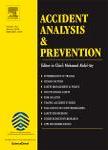版权所有:内蒙古大学图书馆 技术提供:维普资讯• 智图
内蒙古自治区呼和浩特市赛罕区大学西街235号 邮编: 010021

作者机构:Univ S Florida Dept Civil & Environm Engn 4202 E Fowler AveENB118 Tampa FL 33620 USA Univ S Florida Ctr Urban Transportat Res 4202 E Fowler AveCUT100 Tampa FL 33620 USA Chang An Univ Key Lab Automot Transportat Safety Tech Minist Transport 2nd Ring Rd South East Sect Xian 710064 Shanxi Peoples R China Texas Tech Univ Civil Environm & Construct Engn 2500 Broadway Lubbock TX 79409 USA
出 版 物:《ACCIDENT ANALYSIS AND PREVENTION》 (事故分析与预防)
年 卷 期:2019年第123卷
页 面:51-59页
核心收录:
学科分类:0303[法学-社会学] 1004[医学-公共卫生与预防医学(可授医学、理学学位)] 1201[管理学-管理科学与工程(可授管理学、工学学位)] 08[工学] 0837[工学-安全科学与工程] 0823[工学-交通运输工程]
主 题:Motorcycle crash Low mean problem Aggregation-bias issue Matched case-control study Conditional logistic model Crash modification factor
摘 要:Single-motorcycle crashes are overrepresented on horizontally curved segments of rural, two-lane, undivided (RTU) highways. However, the relationship between single-motorcycle crash risk and the design features of horizontal curves on RTU highways is not well-studied in existing literature. This study aims to quantify the effect of horizontal curve type and radius on the risk of single-motorcycle crashes with a matched case-control study that can address the issues of the low sample mean, aggregation bias, and uncontrolled confounders existing in the traditional cross-sectional study. In the matched case-control study, three matching factors-year, annual average daily traffic (AADT), and segment length-were selected to match controls (RTU segments without crash records) with cases (RTU segments with crash records). A total of 1601 cases and 16,010 matched controls over 11 years (2005-2015) were identified as matched-strata. A conditional logistic model was fitted on the matched-strata data to estimate the crash modification factors (CMFs) of horizontal curve design features for single-motorcycle crashes. The modeling results highlighted the interaction effects between curve type and radius on the risk of single-motorcycle crashes. Sharp (radius = 1500 ft) non-reverse curves were identified as the riskiest curve design for motorcyclists, followed by sharp reverse curves and moderate (1500 ft radius = 3000 ft) reverse curves. The study also revealed that motorcyclists might take safety-compensation behaviors on sharp curves, narrow shoulders, and poor pavement conditions. Engineering and education countermeasures are suggested for comprehending curve presence and associated risk level, reducing curve entry speed, and improving safety awareness. Finally, the limitations of the study and possible solutions are discussed.